Antenna Launcher
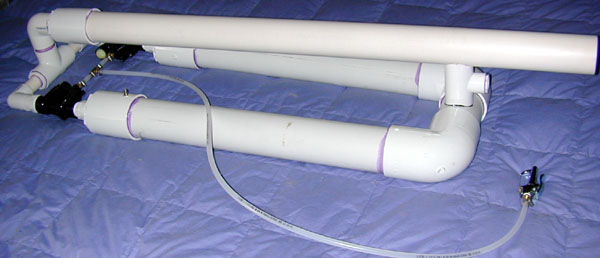

Over the 25 years our Field Day group has been together, we've tried lots of different ways of putting wires into trees in order to raise antennas with varying results. The helium weather balloons worked great as long as the wind didn't blow, but that didn't happen too often and couldn't be depended on. Slingshots had a limited range and were unable to get up into the really tall trees. Bow fishing rigs had been our best launching platform to date, but they required a lot of skill to operate correctly, had some safety issues, and their velocity couldn't be modulated easily, causing them to overshoot the intended target. In 2002, I built something a little different, this pneumatic launcher which was able to bullseye tall trees with amazing precision.
The main inspiration for the launcher were the various models of spud guns around on the internet. In particular, I found the pneumatic tennis ball launcher designs at the Spudgun Technology Center to be the most interesting. Alan Biocca WB6ZQZ and I had some discussions about using something like that for hoisting antennas, and we decided that tennis balls would be the most PC projectile, as it wasn't likely to cause any injury if it came down and was less likely to be looked at askance if someone official happened to take notice of our operations.
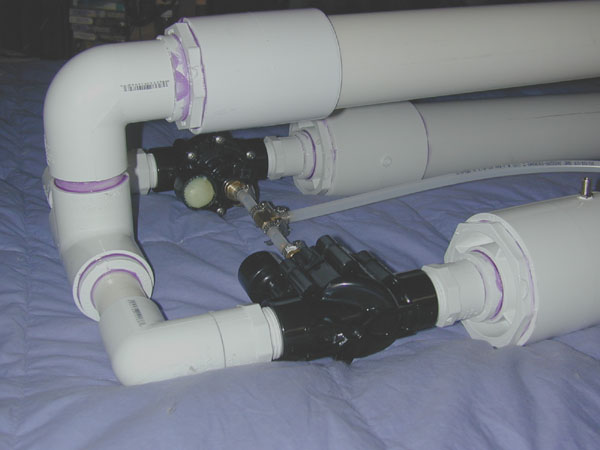
As a way of getting my feet wet, I built an simple over-under design using a 3/4-inch sprinkler valve, but its performance was very disappointing. It was obvious that the solenoid and low flowing sprinkler valve was the bottleneck in the design, so I built the second generation using two Rain Bird CPF-100 one-inch valves in parallel and used pneumatic triggering. Both feed into a 1-1/2-inch T which leads to the 2-1/2-inch barrel, which just happens to be the right diameter to fit a tennis ball. The U-shaped pressure chamber is made of 3-inch tubing with two 90-degree elbows. All tubing is schedule 40 PVC and is rated to over 200lb. The barrel length is about 47 inches, while the pressure chamber is about 32 inches long. By my calculations, the barrel has a volume of about 220 in3 and the chamber 530 in3 for a ratio of about 2.4:1.
The pressure chamber is drilled and tapped 1/4 NPT where the tubing overlaps the joiner sleeve (double thickness) on either end of the U in order to install the schrader fill valve and the pressure gauge. The solenoids were removed from the sprinkler valves and the opening filled with plastic bonding epoxy. The valves were disassembled, the flow rate adjustments were removed, the shaft holes drilled out and tapped 3/8 NPT and a brass barbed fitting screwed into place. Pressure-rated poly tubing joins the two valves with a barbed T, and from there it goes to a dust blower valve which serves as the trigger. Screwed into the nozzle of the dust blower is a ball valve which acts as a safety.
: PVC tubing is not recommended for use with pressurized air. Although this design uses air pressures well below the tubing's rating, any flaw in the tubing or fracture caused by impact to the pressure chamber while pressurized could result in explosive failure and plastic shards traveling at high velocity. If you build a pneumatic launcher of this or any other design, you do so at your own risk. To mitigate this risk, I recommend the following:
- Do not store your launcher outside or where it is exposed to sunlight. Ultraviolet light degrades PVC and causes it to become brittle. Inspect your launcher yearly for cracking or yellowing.
- Do not leave your launcher's pressure chamber pressurized unless firing is imminent.
- Handle your launcher carefully at all times to prevent damage to the chamber, especially when pressurized.
- Wear eye protection when using your launcher, and insist others in the area do so as well.
- Consider putting a safety shield around your pressure chamber. Heavy cloth (old Levi pants legs, for example) or mylar sheeting can be used.
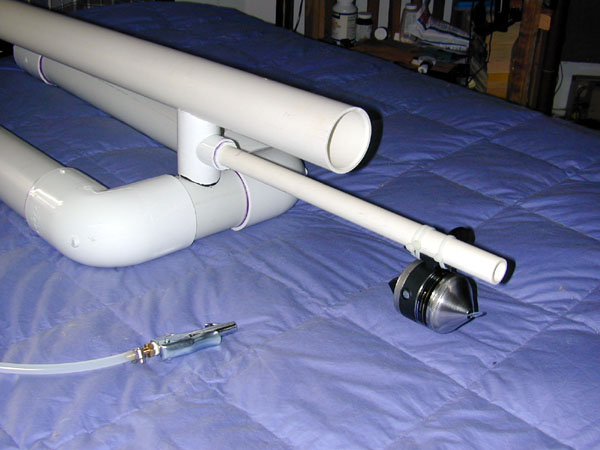
The front support was made from a 1-1/2-to-1-inch T fitting ground with a barrel sander to fit the contour of the muzzle and chamber tubes and glued in place. The 1-inch tap of the T was reduced to 3/4-inch to support the reel handle, which is not glued in place but just friction fit, so that it could be removed for reeling in the line. Note that the reel shown in the picture above was not the one used at Field Day 2002. I thought it would cause too much drag on the line, so I splurged and bought a Penn 6500SS which performed very well.
Once I had assembled the launcher, it was time for some tests.
I took it out to my deck, propped up an old bean bag chair against the
rail as a backstop, and set up my chronometer under the path of the ball
to measure the tennis ball's velocity. Here's what I got:
| Chamber pressure
(psi) |
Muzzle Velocity
(fps) |
| 20 | 77.67 |
| 30 | 173.1 |
| 40 | 237.1 |
| 50 | 284.4 |
| 60 | 323.4 |
| 70 | 362.4 |
At 70psi, the tennis ball tore a hole in the corduroy covering of the bean bag chair and I terminated the experiment. It was clear that this second-generation launcher had more than enough performance for Field Day operations. As a point of reference, the world's record tennis serve speed was set by Greg Rusedski in 1998 at 218.6 fps.
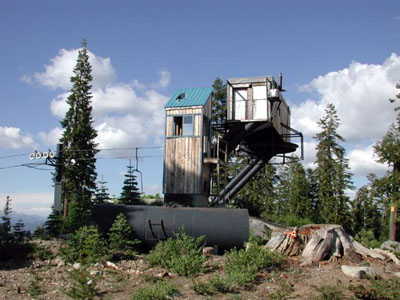
Our field day site for 2002 was the top of a lift for the Iron Mountain ski resort located in the El Dorado National Forest. This was a marvelous location with a clear area surrounded by tall trees, ideal for antenna hoisting. For a while we toyed with the idea of hooking a transmitter to the lift cable.
The Penn reel was loaded with 300 yards of 50lb woven Spectra fishing line. I really liked this line for antenna raising, it was light, didn't tangle (much), and it didn't stretch when yanked so you could really feel what you were up against when pulling the line back in. Although my forest green line was practically invisible, I understand that it is also available in fluorescent colors, which I would recommend. Also remember to have a pair of leather gloves handy when pulling the line -- the thin, strong line can cut unprotected flesh like a knife.
The method I developed for attaching the tennis ball is a little tricky, but seemed to work in general. The first step is to choose a leader line to go between the Spectra and the ball. This line should be of lower breaking strength than your main line in case your ball gets stuck in a tree and you have to pull and break it loose. In my case, I chose 15lb woven Dacron line, but I think that was a mistake because it kept breaking on launch. Next time I will try something with a little more give in it, maybe nylon if I can find some the right weight. Once the leader is chosen, you will need two steel washers, about #10, a knife, a punch, and a crochet hook. The procedure is as follows:
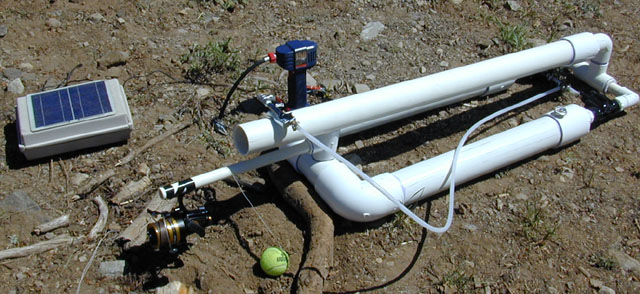
We found through trial and error that the best mounting position for the reel was such that it extended beyond any other part of launcher, so that the line could swing as wide as it needed to as it spooled off of the reel without contacting any obstruction. We initially tried a shortened fishing pole with line guides, but this was a complete failure. The line from the reel to the loaded ball should not be past anything that the line might snag on. In the setup above, a small notch was cut in the tubing the reel was mounted on to guide the line in to the muzzle. Note also the small hand-held 12v compressor and battery pack to power it (the box with the solar panel on top).
The initial live firings of the launcher with line attached almost always resulted in breakage of the leader. As we developed better techniques, we were able to increase the percentage of successful launches, but we were never able to go above about 40psi without breaking a line. In practice, this was more than enough for our purposes, since the highest tree we topped only required 25psi to clear, and most needed less than 20.
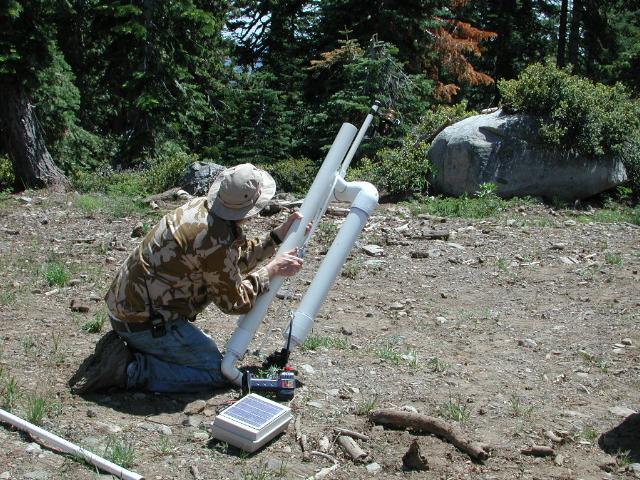
In practice, the launcher performed better than any other antenna raising system we've tried to date. It wasn't so much that the launcher could do things the other systems couldn't do, but that both its high consistency and its ability to be fine-tuned combined to allow us to eliminate the errors of the previous launch without introducing any new errors, almost guaranteeing a second launch success. The tunability of muzzle velocity by varying the pressure also gave us a great deal of flexibility in picking the launch angle in order to land the ball in a clear area on the other side of the tree.
During FD 2002, the pneumatic launcher was used to put up three antennas: two inverted V's, and a 400-foot V-beam, for a total of 5 hoists. The V beam was particularly challenging, since the trees had to be carefully surveyed to yield the correct leg angle and beam heading, and the ones we needed were rarely in convenient places. The usual sequence was to launch the tennis ball away from where the antenna wire would be, then pull back a messenger line (usually day glow nylon engineer's line), then use the messenger line to pull a polypropylene rope into the tree to which the antenna wire was attach and which would serve as the anchor.
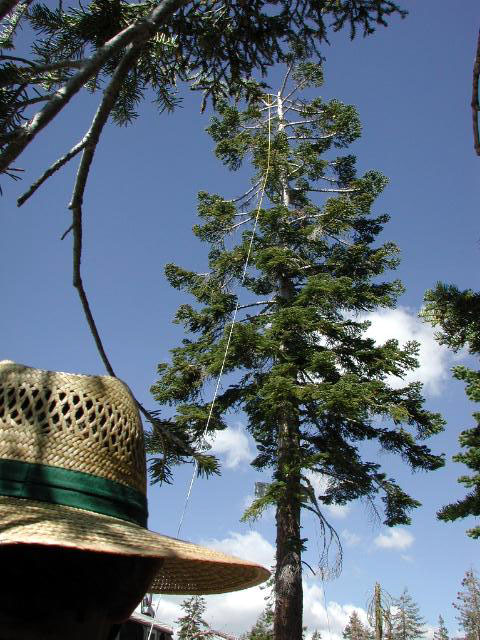
In the course of putting lines up in trees, we learned the following:
Reel systems could use a lot of improvement. I'd like to try some open faced bowfishing reels at some point and see if they're any improvement over the Penn. The trick is to be able to handle line at speeds much higher than most fishing reels were designed for. More research needs to be done.
A heavier projectile would improve things considerably. Not only would more weight pull the line out of the trees better, but they would have a better ballistic coefficient and the energy transfer from the compressed air to the projectile would be much more efficient, allowing you to use cheaper valves. We're still looking for one that has the right density, fits a standard sized PVC pipe, and can be attached to a line. It would also be nice if it wouldn't injure anyone if it landed on them, though we can handle that with added safety precautions if we need to. If you have any ideas along these lines, please drop me a note.
WB6ZQZ has put a lot of work into computer models that simulate what
goes on in a pneumatic launcher. The results are very interesting
and often surprising. The code is very ad-hoc and not user-friendly,
but you're welcome to play with it if you want, Python source code is here.
